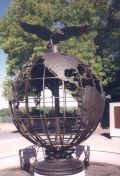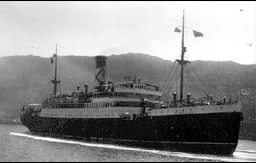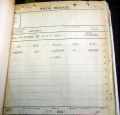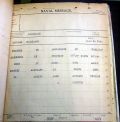ANDREWS, Frank, Age 34, Quartermaster Canadian Merchant Navy, Newfoundland, Panel 19.
AYLWARD, Joseph, Age 39, Steward Canadian Merchant Navy, Newfoundland, Panel 19.
BAILEY, Malcolm, Age 26, Boatswain (Bosun) Canadian Merchant Navy, Newfoundland, Panel 19.
CANDOW, James, Age 32, Sailor Canadian Merchant Navy, Newfoundland, Panel 19.
CARTER, Allister Karl, Age 20, Able Seaman Canadian Merchant Navy, Newfoundland, Panel 19.
CRAIG, Gordon Robert, Age 18, Ordinary Telegraphist Royal Canadian Navy, British Columbia, Panel 5.
CRAIG, Wilson Henry, Age 20, Ordinary Telegraphist Royal Canadian Navy, Alberta, Panel 5.
FORD, Cecil, Age 25, Able Seaman Canadian Merchant Navy, Newfoundland, Panel 19.
HARVEY, Barnett, Age 20, Sub-Lieutenant Royal Canadian Navy, British Columbia, Panel 5.
KITCHING, Stuart Templeton, Age 20, Ordinary Telegraphist Royal Canadian Navy, British Columbia. Panel 5.
LANGMEAD, William Francis Ryan, Age 28, Able Seaman Canadian Merchant Navy, Newfoundland. Panel 19.
McCRINDLE, Robert Reynolds, Age 20, Ordinary Telegraphist Royal Canadian Navy, Alberta, Panel 5.
McEVOY, Ronald, Age (unknown), Able Seaman Canadian Merchant Navy, Newfoundland, Panel 19.
RAINE, Earle Sturdee, Age 19, Able Seaman, Canadian Merchant Navy, Nova Scotia, Panel 19.
SNOW, Henry, Age 53, Oiler Canadian Merchant Navy, Newfoundland, Panel 19.
STINCHCOMBE, Arthur Roland, Age 20, Ordinary Telegraphist Royal Canadian Navy, Ontario, Panel 5.
THORNE, Kenneth, Age 28, Able Seaman Canadian Merchant Navy, Newfoundland, Panel 19.
TILLER, William, Age 21, Scullion Canadian Merchant Navy, Newfoundland, Panel 19.
WICKS, James, Age 27, Quartermaster Canadian Merchant Navy, Newfoundland, Panel 19.
WILLIAMS, Albert, Age 30, Able Seaman Merchant Navy, Newfoundland, Panel 19.
YOUNG, Edward, Age 36, Fireman Canadian Merchant Navy, Newfoundland, Panel 19.
AMOS, Maurice Auguste, Age 29, Lieutenant Royal Candian Army Pay Corps, Quebec, Panel 14.
ANSON, Lawrence Warton, Age 29, Q.M.S. Royal Canadian Ordnance Corps, Ontario, Panel 14.
ASHWORTH, Victor Lawrence, Age 21, Private Canadian Army C.M.S.C, Quebec, Panel 14.
AUBIN, Etienne Joseph, Age 24, Sergeant Canadian Army C.M.S.C, Ontario, Panel 14.
BALTUS, John Henry, Age 27, Q.M.S. Canadian Army C.M.S.C, Saskatchewan, Panel 14.
BATEMAN, William Robert, Age 20, Sergeant Canadian Army C.M.S.C, British Columbia, Panel 14.
BELYEA, Graham Stanley, Age 20, Corporal Canadian Army C.M.S.C, Manitoba, Panel 14.
BENTLEY, Owen Newton, Age 26, S.M. Canadian Army C.M.S.C, British Columbia, Panel 14.
BOULANGER, Jean Maurice, Age 26, Lieutenant Royal Canadian Army Pay Corps., Quebec, Panel 14.
BROOKES, Jack, Age 30, Sergeant Royal Canadian Artillery, Nova Scotia, Panel 14.
BROWN, George, Age 19, Private Canadian Army C.M.S.C, Ontario, Panel 14.
BUDDELL, William Frank, Age 21, Corporal Canadian Army C.M.S.C, British Columbia, Panel 14.
BURNESS, Kenneth Charles, Age 47, Lt. Colonel Princess Patricia’s Cdn. Lt. Infantry, Ontario, Panel 14.
BURNS, John Anderson, Age 20, Sergeant Canadian Army C.M.S.C, Saskatchewan, Panel 14.
CALDWELL, William, Age 35, W.O.I Royal Canadian Ordnance Corps., Ontario, Panel 14.
CAMERON, Robert Laird, Age 29, Q.M.S. Royal Canadian Engineers, Ontario, Panel 14.
CAMPBELL, Faber Romanus, Age 20, Gunner Royal Canadian Artillery, Prince Edward Island, Panel 14.
CHATW1N, George Thomas, Age 44, Captain Royal Canadian Army Pay Corps., Manitoba, Panel 14.
COLLINS, John Wafer, Age 27, Sergeant Canadian Army C.M.S.C, Ontario, Panel 14.
DAVIDSON, William Alexander, Age 18, Private Queen’s Own Cameron Highlanders, Manitoba, Panel 14.
DOHERTY, David James, Age 32, Gunner Royal Canadian Artillery, Nova Scotia, Panel 14.
EDWARDS, Robert Allan, Age 19, Corporal Canadian Army C.M.S.C, Alberta, Panel 14.
EMBREE, William Hazen, Age 31, Captain Royal Canadian Army Medical Corps., Nova Scotia, Panel 14.
FAWCETT, Ronald Thayer, Age 36, Lieutenant New Brunswick Rangers, R.C.1.C, New Brunswick, Panel I4.
FISHER, Ivor Franklin, Age 21, Signalman Royal Canadian Corps of Signals, New Brunswick, Panel 14
GARDNER, Douglas Raymond, Age 26, Staff Sergeant Royal Canadian Army Service Corps., Ontario. Panel 14
GLATT, Harold, Age 22, Corporal Canadian Army C.M.S.C., Ontario, Panel 14.
HAMILTON, James Sydney, Age 22, Sergeant Canadian Army C.M.S.C., Manitoba, Panel 14.
HARDING, Frederick George, Age 28, Sergeant Canadian Army C.M.S.C, British Columbia, Panel 14.
HUTTON, James, Age 21, Ordinary Telegraphist Royal Canadian Navy, Alberta, Panel 5.
IRVINE, Harold Wellington, Age 22, Sergeant Canadian Army C.M.S.C, Ottawa, Panel 14.
JOHNSTONE, Charles James, Age 37, Corporal Canadian Provost Corps., Saskatchewan, Panel 14.
KIPPEN, James Wendell, Age 25, Captain Royal Canadian Army Medical Corps., Manitoba, Panel 14.
LEADBETTER, John, Age 33, Corporal Canadian Army C.M.S.C, British Columbia, Panel 14.
LEIB, Ernest, Age 24, Private Royal Canadian Ordnance Corps., Manitoba, Panel 14.
LESEIZE, Henri, Age 34, Private Le Regiment de Maisonneuve, R.C.I.C, Quebec, Panel 14.
LESTER, Harold Robert, Age 18, Ordinary Telegraphist Royal Canadian Navy, Saskatchewan, Panel 5.
LONG, Richard Brady, Age 22, Staff Sergeant Canadian Army C.M.S.C, Ontario, Panel 14.
MacDONALD, Neil Richardson, Age 25, Sergeant Canadian Army C.M.S.C, Ontario, Panel 14.
MADSEN, Clinton Edward, Age 33, Sergeant Canadian Army C.M.S.C, Ontario, Panel 14.
MAYNARD, John Robert, Age 26, Staff Sergeant Royal Canadian Army Medical Corps., Nova Scotia, 14
McGOVERN, Farrell James, Age 28, Sergeant Canadian Army C.M.S.C, Ontario, Panel 14.
McKAY, Wallace Andrew, Age 26, Sergeant Royal Canadian Engineers, Manitoba, Panel 14.
McLEOD, William John Barry, Age 33, B.S.M. Royal Canadian Artillery, Ontario. Panel 14.
MILLS, William Robert Neilson, Age22, Lance Sergeant Royal Canadian Engineers, Nova Scotia, Panel 14.
MORRIS, Frederick Earl, Age 23, Private Queen’s Own Cameron Highlanders R.C.I.C., Saskatchewan. Panel 14.
MUIR, William Edward, Age 39, Sergeant Canadian Army C.M.S.C, Ontario, Panel 14.
NIXON, Francis Robert Woodcock, Age 37, Paymaster Com. Royal Canadian Navy, British Columbia. Panel 5.
PARK, Samuel, Age 34, Captain Royal Canadian Army Medical Corps., Quebec, Panel 14.
PETTIT, Howard, Age I8, Sergeant Canadian Army C.M.S.C, Ontario, Panel 14.
PHILLIPS, Donald Octavius, Age 25, Armt Q.M.S. Royal Canadian Ordnance Corps., Ontario, Panel 14.
PHILLIPS, James Arthur, Age 18, Private Canadian Army C.M.S.C Ontario, Panel 14.
ROBINSON, George Louis, Age 21, Sergeant Canadian Army C.M.S.C, Quebec, Panel 14.
ROSE, Lloyd William Alexander, Age 29, Corporal Canadian Army C.M.S.C, Nova Scotia, Panel 14.
SCANLON, Richard Pirt, Age 23, Private Canadian Army C.M.S.C, Manitoba, Panel 14.
SHEA, Omar Cornelius, Age 26, Q.M.S. Royal Canadian Army Medical Corps., Saskatchewan, Panel 14.
SLATER, John Frederick Richard, Age 24, Private Canadian Army C.M.S.C. Saskatchewan, Panel 14.
STARKE, Arnold Thomas Francis, Age 19, Bombardier Royal Canadian Artillery, Ontario, Panel 14.
TRITES, James Albert, Age 32, Lieutenant Carleton and York Regt. R.C.I.C., New Brunswick, Panel 14.
TRUDELL, Jean, Age 34, Staff Sergeant Royal Canadian Army Medical Corps., Quebec, Panel 14.
TURNER, Clifford Redverse, Age 21, Sergeant Canadian Army C.M.S.C, Quebec, Panel 14.
WELLS, Reginald Lawrence, Age 31, C.S.M. Royal Canadian Corps of Signals, USA, Panel 14.
WITTAKER, Thomas Sidney, Age 41, C.S.M. Royal Canadian Corps of Signals, Alberta, Panel 14.
WILKINSON, Leslie Angus Cecil, Age 26, Corporal Canadian Army C.M.S.C, Ontario, Panel 14.
WILSON, Bill Omar, Age 24, Sergeant Canadian Army C.M.S.C, Ontario, Panel 14.






